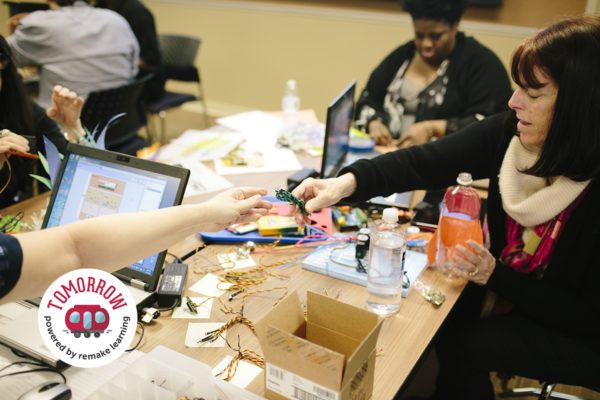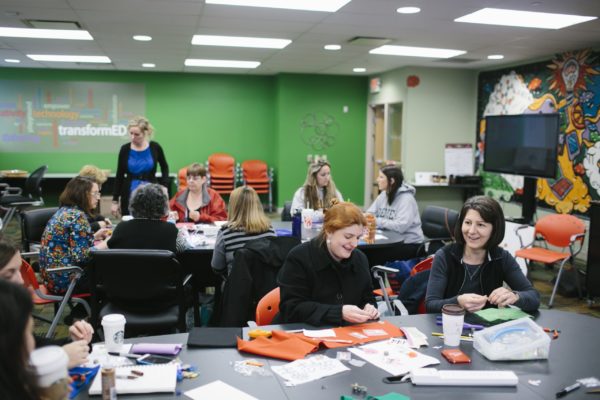
Teaching tomorrow’s teachers: Imagining the future of professional development for educators
By Melissa Rayworth
It’s one of the most difficult things about being a public school teacher, yet it often goes unnoticed: Along with teaching, teachers have to be constantly learning.
The amount of time they’re given to accomplish this task, and the methods by which they’ve traditionally done it, haven’t exactly made things easier.
“Teachers are very busy people, and there’s really not enough time in the day for anything, especially their own learning,” says Allyce Pinchback-Johnson, who led Remake Learning’s Professional Learning Collaborative and now leads the organization’s Shifting Power initiative.
How can teachers keep moving forward each year, learning new things and sharing knowledge with each other — especially during a time of unprecedented change and, not incidentally, challenging communication?
The work of education innovators in Pittsburgh has begun pointing the way. That work has now been shoved forward by an unlikely accelerant— COVID-19 disruption — and this recent stride forward has helped clarify what the future of professional development for teachers could look like.
Before the virus, teachers got just a handful of days each year to learn new curriculum, master new methods of teaching and share best practices. They’d gather in groups of several dozen (or more likely, several hundred) for daylong presentations that might or might not prove useful.
Competing agendas often surfaced: Within a district’s administration, everyone had ideas about how these few days of annual professional development (known in the education world simply as “PD”) should be spent.
To improve on all of this in the Pittsburgh region, since 2017 the Professional Learning Collaborative has been connecting local organizations that offer PD to help them collaborate, innovate and reduce duplication.
And since 2011, the Allegheny Intermediate Unit’s transformED initiative has been growing a culture of peer-to-peer learning during hands-on workshops that introduced classroom teachers to local librarians, museum staff and educators from nonprofits and enrichment programs. The goal: to bring the same innovations that are improving student education — collaborative projects, hands-on learning and encouraging individual interests — to the teaching of teachers.
More than 100 districts now participate, according to Remake Learning’s “Learners First” report.
But even in districts open to improving their PD, a real embrace of new approaches only came after a “slow, reflective, thoughtful process,” says Jeff Evancho, assistant to the superintendent for secondary education at the South Fayette Township School District, southwest of Pittsburgh.
Then came the virus.
Progress went into overdrive, Evancho says, because the need was so great. The old “let’s all gather in a room” model of PD was suddenly impossible at exactly the time when teachers were being asked, without warning, to become masters of remote teaching and connecting with kids quarantined at home.
So innovative PD began growing — and pointing the way toward a more impactful future.
A RANGE OF GOOD RESOURCES
TransformED pivoted to quickly teach teachers how to use digital tools and reach students in their homes.
“We had to quickly rethink how we provided PD,” says Tyler Samstag, director of instructional innovation at the AIU. “We created a model of PD that was a mix between asynchronous content and synchronous, virtual PD, as well as opportunities for coaching — sort of open office hours.”
Online PD wasn’t new. But this combination of scheduled online classes, digital resources available any time and personal coaching meant that each teacher could focus on what they most needed to learn.

Giving teachers that autonomy is important, says Pinchback-Johnson: “A piece of this is really trusting teachers to make the best decisions for their time.”
There’s just one caveat: The need for this digital training points up the same divide for teachers that we saw last spring for students. “Sometimes people forget teachers have families, too,” Pinchback-Johnson says. A teacher may have two children and a spouse, and those four members of the household may share two devices and limited wifi.
In order to really support our teachers in the future, ensuring their access to devices and wifi is vital. But assuming that piece is in place, teachers will have a growing range of resources to pull from.
This year and beyond, districts will be “leveraging the video library that we create, by having small groups of teachers work through different tutorials and different online MOOCs,” Samstag says. And “there’s going to be a massive amount of coaching through external partners and building internal capacity, and teachers coaching one another.”
POWERFUL MENTORSHIP
Teachers have always coached one another informally. But Evancho says this practice has grown exponentially in recent months.
“We spent years designing systems for peer-to-peer learning and all of these different types of frameworks,” he says. But when the school disruption began, “teachers would pick things up and share with each other in ways that were almost hard for us to keep our finger on.”
Along with veteran teachers helping newer staff, Samstag says many younger teachers with strong digital skills have been mentoring more senior teachers.
The enthusiasm is clear: When transformED put out a call for teachers to share innovative work and effective practices they used last spring, Samstag’s team hoped they end up with enough content for a week of programming. “We ended up getting about 70 submissions, so we did two weeks full of teacher-led sessions that really ran the gamut from preschool to high school to intervention. We had counselors, we had art teachers — a little bit of everything.”
MAKING TIME FOR WHAT MATTERS
Of course, in order to make the most of new resources and the growing availability of mentorship, teachers need more time to do this work. Some schools are prioritizing that: “We just board-approved a new calendar to build in more PD days,” Evancho says, including “seven days across two weeks to have our teachers together.”
But traditionally, any day that teachers spent on PD was a day when their students were sitting idle. Before the school disruption, that had always been a roadblock to districts granting more PD days. “There’s a need for PD and for uninterrupted time for teachers to learn and collaborate,” Pinchback-Johnson says. “But what does that mean for families who rely on schools to be where their kids are?”
The solution, in her opinion, is something that education innovators have discussed for years and the school disruption has highlighted: Creating a true learning ecosystem, with the whole community involved.
Districts could approach the many out-of-school-time organizations in their community and invite them to create a program of studies to do with students at the school on PD days (or virtually, during quarantine).
Given how many people and organizations have publicly committed to philanthropy, volunteerism and social responsibility for kids, Pinchback-Johnson says, there’s no reason for kids not to get this type of wraparound support.
“It takes strong leadership at the superintendent level and at the school board level to say, ‘We are going to truly invest in community partnerships for our district. Because, guess what? We can’t do it alone,” Pinchback-Johnson says. “There are people out here who are doing things that really benefit our kids. And if we tap into that, then we can make the experience for our kids better.”
Want to know more about teacher professional development in Southwestern Pennsylvania? Check out the data and discoveries in Remake Learning’s “Learners First: how educators hone their craft” report.
This article is part of a series for ‘Tomorrow’ powered by Remake Learning. From May to October, “Tomorrow” will explore – through virtual events, grantmaking, and storytelling – what we can do today to make tomorrow a more promising place for all learners. Follow along or share your hopes for today’s young people using the hashtag #RemakeTomorrow and tagging @RemakeLearning. Learn more about Remake Learning here. And read more “Tomorrow” articles published on Kidsburgh.
